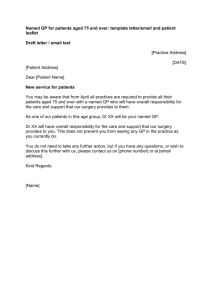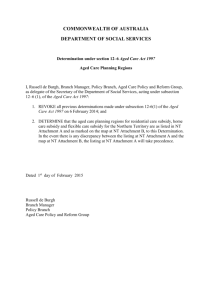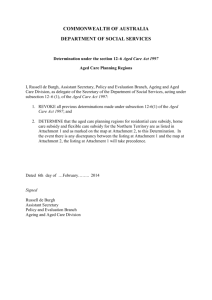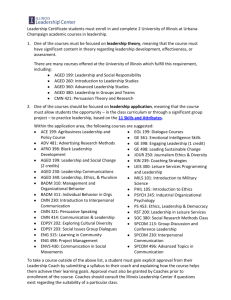Lost Generation
advertisement
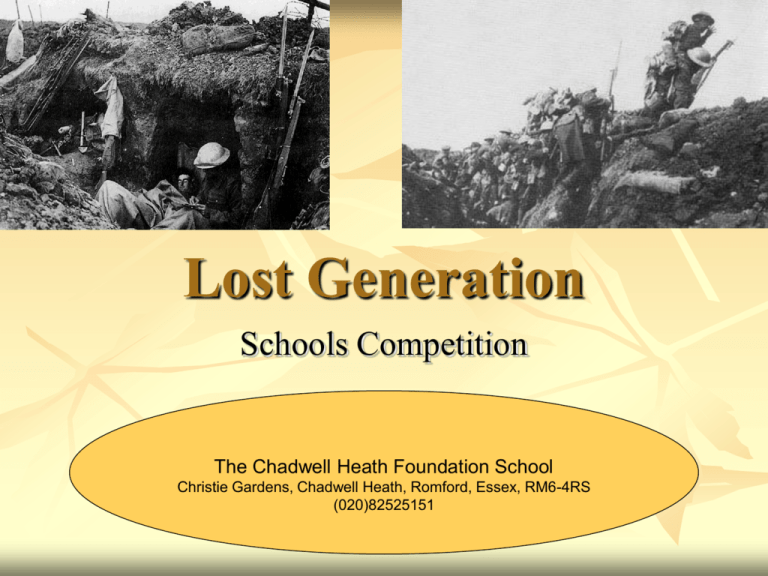
Lost Generation Schools Competition The Chadwell Heath Foundation School Christie Gardens, Chadwell Heath, Romford, Essex, RM6-4RS (020)82525151 Our Project… For our contribution to the Channel 4 Lost Generation endeavour, we decided to adopt a memorial in our local area. We looked at our options and we chose to investigate the memorial located on the western wall at Saint John’s the Evangelist, Seven Kings, Ilford. The memorial consists of two plaques: One a dedication to the men who gave their lives for their King and Country The other, a list off the forty-four men who joined up and never came back. It was these posters that got the British men to join up to serve for their King and Country… Some were lucky enough to make it back, but not necessarily alive… Many were left dead in the trenches Commemorated by a small wooden cross in future times… It is our attempt to recognise the boys and men from St. John’s Church who lost their lives in the Great War Their lives Their community Their service Their death LOCATION: St. John the Evangelist Church, Seven Kings, Ilford, Essex, IG2 7BB View approaching the western wall, alter and communion rail. The two tablets are located either side of the arch. The Southern Tablet ST. JOHN’S 1914 1918 To the Glory of God who gave us the victory and in grateful remembrance of the courage and selfsacrifice of those connected with this church who served their KING and COUNTRY in the GREAT WAR 1914–1918 “Through God we shall do valiantly, for it is He that shall tread down our adversaries.” The names of those who died for us are inscribed on the tablet on the north side if this wall. The Northern Tablet Our Aim We have attempted to research and discover the lives that were lost from the names that are engraved on the tablet We have succeeded in uncovering six stories behind their names: 1. 2. 3. 4. 5. 6. R.F. Saunders S.W. Allen L.J. Millage W.H. Moore R.F. Moore G. Joy This photograph is of the St. John’s Football Club in the 1911 – 1912 season The photograph is backed with cardboard, on which were the names of each member of the football club. The four rows of names were split evenly above and below (i.e.: two rows above the photo, two rows below.) Unfortunately, between the years of 2004 and 2006 the bottom two rows of names has somehow been destroyed. Only two names are distinguishable from the lower two rows: W.H. Moore Rev. Peabody St. John’s F.C. The photo says a lot about the local community at the time of it’s taking. It shows us that the church is at the centre of the community; that men came and participated in a game from all over the parish. This point is furthered with the Reverend Peabody in the centre of the photograph Incidentally, it is recorded that he was in charge of St. Mary’s (St. John’s mother church) football and cricket teams, as well as St. John’s Comparing the Photo and the Memorial If we compare the names available from the photograph, it’s quite disturbing how many occur on the memorial: L.J. Millage S.W. Allen N.B.: G. Joy is known to be somewhere in the bottom two rows R.F. Saunders S.W. Allen W.H. Moore L.J. Millage R.F. Moore(?) The faces circled in yellow are those whose names appear on the memorial. S.W. Allen S W Allen was a Corporal in the Army Pay Corps. His service number was 8090. He died on the 7th November 1918 – four days before the end of the War His body now lays in Aldborough Hatch Cemetery at St. Peter's Church. G. Joy The son of Frederick George and Eleanor Joy – 7, Glencoe Avenue – was a second Lieutenant in the London Regiment He was awarded the Military Cross Gwyn died on 16th July 1917, at the age of 23, in France. He is buried at St. Sever Cemetery, in Rouen. L.J. Millage Lawrence John Millage was the son of Amy and the late John Stuart Millage, who also died in the war. Lawrence was a Private in the Prince of Wales' Own Civil Service Rifles, London Regiment. Dying on 18/05/1915, Lawrence was 21. R.F. Moore Robert Frank Moore was the eldest to Moore sons who died in World War One. The son of Charlotte Moore and the late Robert Nelson Moore, Robert was a Lieutenant Colonel and awarded the Military Cross and the Distinguished Service Order. He died at the age of 28 on 30/05/1918, and is remembered on the Soissons Memorial, France. W.H. Moore Winifred Hubert Moore, died after his brother, on 1st September 1918 at the age of 27. As a Sergeant, he was awarded the Meritorious Service Medal. He was in the 15th Battalion of the Prince of Wales' Own Civil Service Rifles, London Regiment, coincidently the same battalion as L.J. Millage. Winifred lies at the Peronne Road Cemetery, Maricourt, France. R.F. Saunders Little can be found on Ronald Frank Saunders. It is apparent that he resided in Goodmayes. When, where and how old he was when he died is unknown. The face circled in blue is that of a third Moore brother. C. Moore C. Moore appears on the football photograph, but not on the memorial and no record of him can be found. It can only be presumed that he didn’t go (for medical reasons or personal values) or he came back. Now, there are two more faces that have been circled in green. The Green Circles These are of S. Cook and C.B. Smith. Lieutenant Sydney Cook was killed in action at the Battle of Passchendaele on 12 October 1917. Charles Brock Smith of 11th London Regiment, died of wounds on 11th September 1916 during the Battle of the Somme. His brother, Frederick Allam Smith, died on 25th May 1915. However, their families chose to not have them commemorated on the church memorial. It an attempt to recreate the emotions of the First World War, we have written three letters. However, these letters would not have reached their recipients as they were originally written. This was because the Defence of the Realm Act (1914) enabled the government to censor what the soldiers wrote home in order that the public remain unaware of the terrible conditions of the front line, so they would be successful in the continuation of recruitment of troops. Letter One – 6th December 1914 Dear Mother, I’m not too tired or worn out yet. It’s awful here; it’s hard work and a totally different lifestyle to at home. We have settled into a daily routine. We are using a tactic called ‘Over the Top.’ This is where we are sent over the top of the trench and charge towards the German trenches. This is the scariest part of our day and if you’re lucky enough to survive you have to do it all over again tomorrow. We have to get up early; no more late mornings. We fright for hours on end fighting the Germans. Here you have to keep your wits about you. I am fearful for my life and hope that I will be returning home soon. I never used to be scared at work and complained about how boring life was; I would rather be at home now. The officers are more concerned about their own safety than ours. We only ever see junior officers; never anyone higher. The food here is barely edible and there’s very little choice, but if you’re hungry you’ll eat it. It’s nothing like your cooking, which I long to taste. Everyday we face the Germans who are constantly trying to shoot and kill us. I miss you and hope to be returning home soon. Have you heard from father yet? Your dear son, Lawrence Letter Two – 17th October 1916 Dearest Mama, It is terrifying here; there are gunshots echoing in the trenches all the time. We are fighting for survival, never mind against the Germans; it’s every soldier for himself. We are all feeling the physical and emotional strain that the war is causing us. We are very weak and are struggling to survive on our inadequate diet of small meals and the conditions we serve in. Since the beginning of the war, many members of our battalion have died. I hope to be able to come home soon, but the only people allowed home are the ones who are injured and incapable of fighting. The food here is nothing like you cook at home. Truth be told: it’s much worst. I should be able to see you soon. I love and miss you all dearly. Give my love to Gina. Love You Lots, Gwyn xxx Letter Three – 24th July 1917 My dear sister Maggie, Has anyone heard from Winifred? I cannot stand being here and I long to be back home. It has been so long that I have forgotten the feeling of our cosy living room and the smell of the lovely food that always seemed to be cooking. I don’t know how the food here can be classified as anything with a resemblance to food. I have lost all my pals. I’ve not yet been sent ‘Over the Top,’ but the prospect is absolutely petrifying. I have contracted deep wounds from flying shrapnel and bruises from our sleeping arrangements. There are rats in our trenches so disease and infection run wild here. Each day we have to deal with the loss of at least one fellow soldier in our trench. There are hardly any of the original crowd left. I hope that I will be returning home alive and well. We are dying from malnourishment. Please send my love to all our friends and family at home. I dream of coming home one day… I can but dream… With All My Love, Robert xxx Trench Life It is a well known fact that those living in the trenches had to live in appalling conditions. Low spirits were trampled with wet, muddy conditions. Soldiers could rarely sleep well, in the cold dug-outs, sharing their blankets with the rats, which were rumoured to be the size of cats. Each day began with the morning hate; cross-fire across NoMan’s-Land, that echoed for several minutes. Lunch was a standard meal of tinned meat with stale bread. Men were supplied with rum to keep them warm in the Winter, from the cold, wet conditions. They were unable to drink the chloridetreated liquid, transported from miles away. Each season brought a bout of disease upon the open-topped trenches, which were often flooded. Vicious diseases such as trenchfoot, pneumonia, dysentery and bronchitis ran rife around the front line. Soldiers didn’t wash for weeks, so they were infested with lice, boils and bunions. Trench Life cont’d. Fully grown men were reduced to levels where they cried and screamed like young children, suffering from depression. Hopes wavered and collapsed of the men ever seen their families and friends again while they began to question their reasons for joining up. Some English soldiers began to feel terrible, when they had to unleash their weapons on the German soldiers, knowing that they were just as innocent as they themselves were. Whilst others, tried to maintain their feelings of loyalty, patriotism and nationalism for their “King and Country.” Soldiers knew that being sent ‘Over-the-top’ was suicide. Those lucky enough to stay behind watched their pals die on No-Man’s Land and later, watch their rotting flesh being eaten by the rats. Emotions were only worsened by delayed discharge. Front line duty was only meant to consist of two weeks, when soldiers would be sent to work in support and reserve for four days each and then rest. Soldiers were kept on the front line, in some cases for months on end. Lost in the mist of time, it is our only assumption that the boys from St. John’s Church suffered the likely fate as the other young English men did. It is a distressing thought: trying to imagine one of the boys in the trenches, up to his waist in water, living with massive rats… For this, we must NEVER forget what they sacrificed and what they were fighting for, because… S W ALLEN F ANDEWS H J ARNOLD E W BAKER W F C BAKER K BEST S COOK R DENNIS F DRAKE J V DRAKE H W EVANS A H FABIAN E FUGLER E C GALPIN H A HARSANT L HARTIN F JACKMAN G JOY F W MACHESTER J S MILLAGE L J MILLAGE R F MOORE Aged 19 Aged 35 Aged 24 Aged 19 Aged 19 Aged 20 Aged 21 Aged 20 J C MURCH J H B NORTON C W OGILVIE A V PAUL E E PENTON H A PETTY S POPPY F C POSTLETHWAITE A PRYOR R A ROBINSON A L ROLFE R F SAUNDERS C B SMITH F A SMITH L G STENNING S N STENNING W C THOROGOOD W F TURNER F G TWIGDEN G T UNDERHAY G WHALEY E D WILES Aged 29 Aged 28 Aged 21 Aged 22 Rest in Peace, Heroes of Britain Aged 21 Aged 23 Aged 22 Aged 55 Aged 21 Aged 28 Aged 22 Aged 21 Aged 26 Aged 21 Aged 18 Aged 34 Aged 28 Aged 19 Aged 22 Evaluation In order to begin our project, the first task we had to overcome was choosing to adopt a memorial or a Tommy. We decided as a three that we would be able to bring out our best abilities in adopting a war memorial. We then decided to investigate the church memorial at St. John’s Seven Kings as it was easier to access than nearby memorials and we also thought it would produce a better result, as archives were easier to access. As our first steps, we contacted people within the church who would be able to help us. Mr L. P. Amann gave us background information and access to the football photograph, which centred out project. Mrs J. and Mr R. Keenan then extended our knowledge as to the photograph and other World War One knowledge. So as to gain records to our fallen men, we took to the internet. After two lessons of solid research into finding records, we eventually stumbled upon the CWGC, which allowed us to search their database of casualties freely and accessibly. We also went to the Western Front Association, where we contacted three members, who each helped us along our way to completing our project with their own contacts and previous research. By using the 1837 census that has recently been posted on the internet, we were able to gain further knowledge of a few men who were untraceable. And when we found historical facts that puzzled us, we went to First World War.com, who were able to point us in the right direction, helping us to understand the events. Of course, we met problems on the way, such as the damaged photograph, limited access to records and restricted information, but it is all part of historical research; if everything were simple and easy to research, then there would be no need for the activity, deeming it pointless. We hope you have enjoyed our project and that you have found it honouring and grateful to our fallen heroes. Sara James, Rebecca Smith and Zeenat Pelaria, Year 9, CHFS Bibliography We would like to send many thanks to the following organisations/ people for all their help. Without them, our project would never be what it is. St. John’s Church, Seven Kings The Commonwealth War Graves Commission 1837 online First World War.com Western Front Association Mr L. P. Amann (St. John’s) Mrs J. and Mr R. Keenan (St. John’s) Mr F. Summerson (Western Front Association) Mr P. O’Mara (WFA) Ms M. Young (WFA) Mr D. Thompson (Head of Humanities and our inspiring, History teacher)
